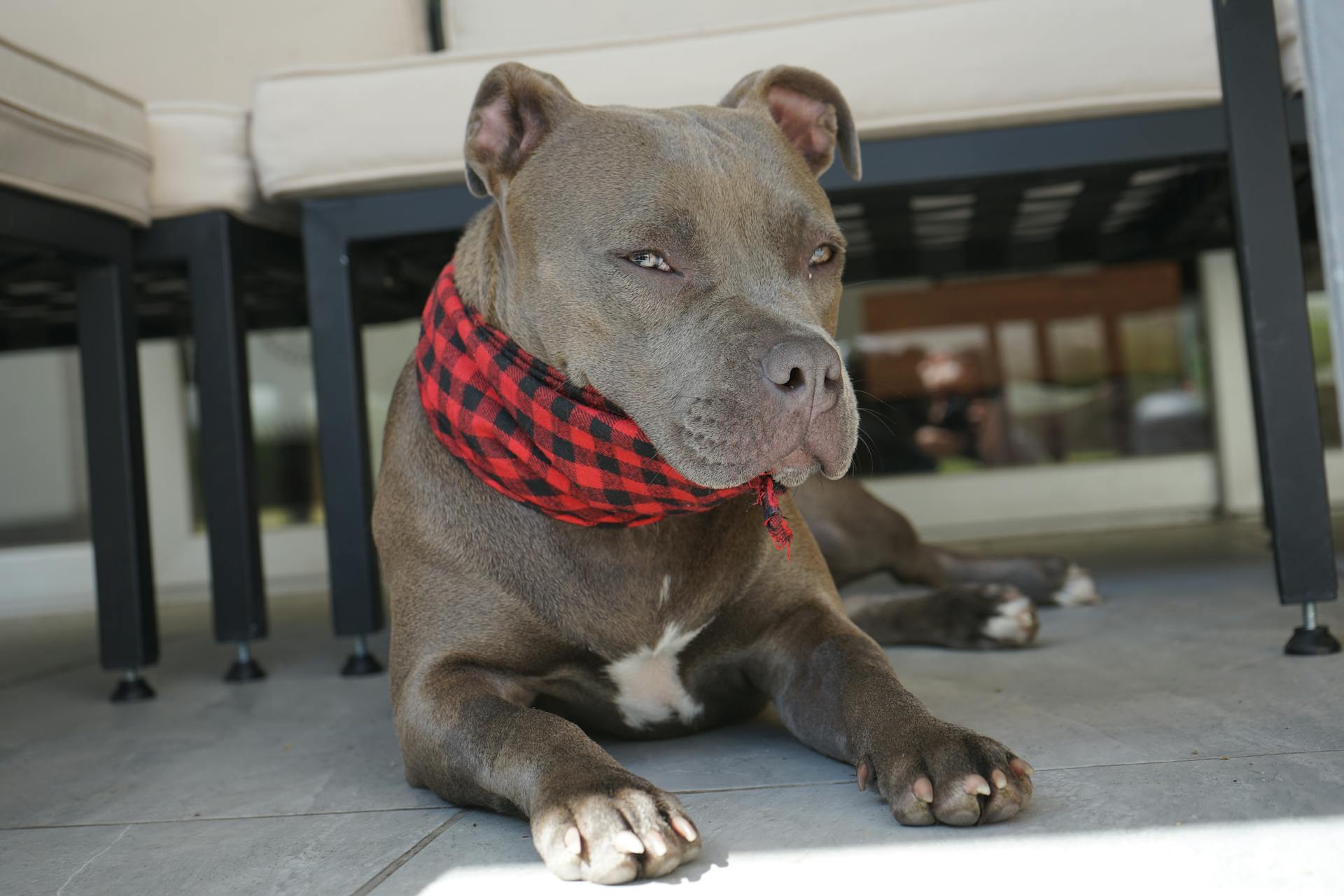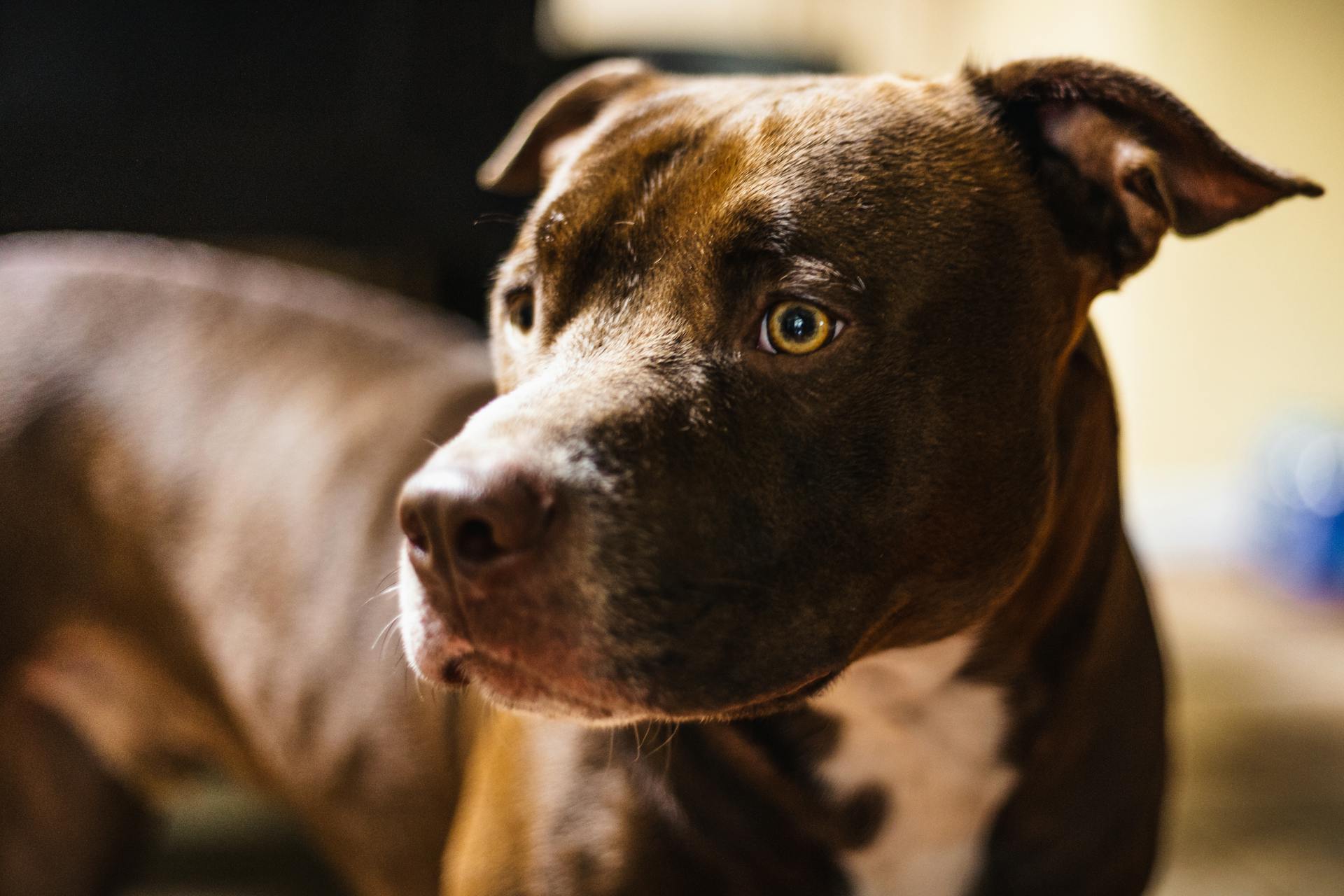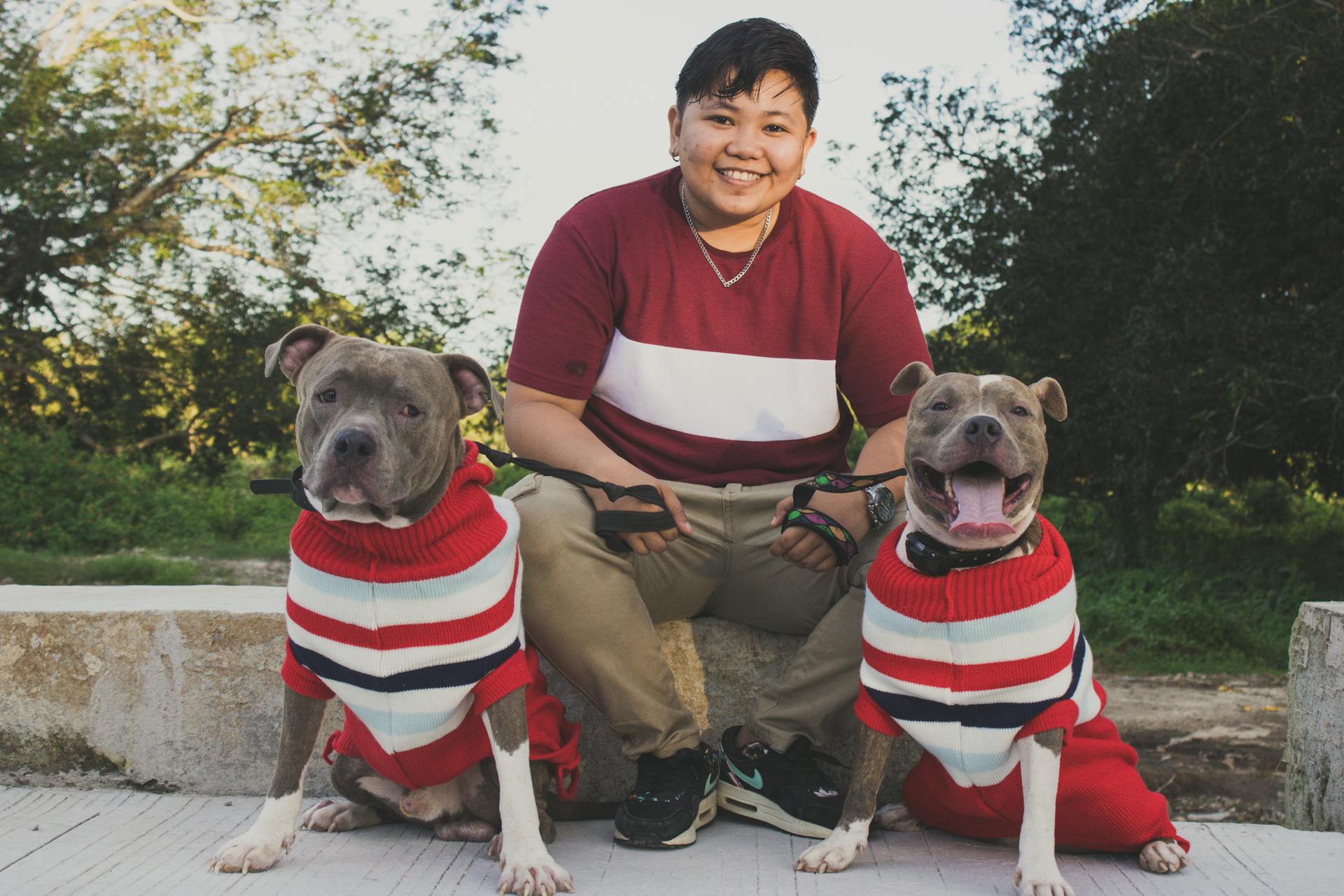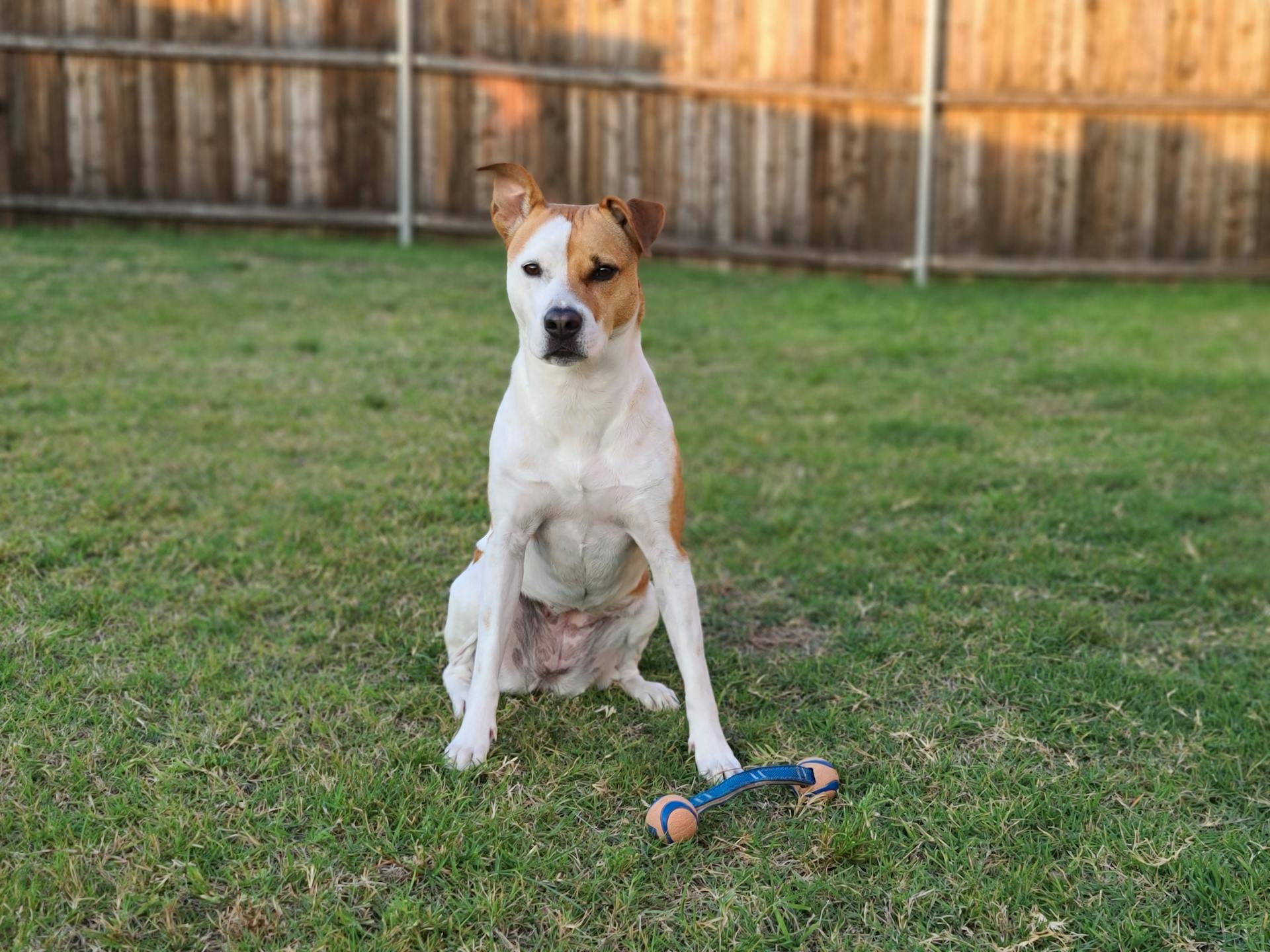
Pit bulls are prone to ear infections due to their floppy ears, which can trap moisture and create a warm, humid environment that's perfect for bacterial growth.
Regular ear cleaning is essential to prevent infections and maintain your pit bull's ear health.
Dirty ears can lead to painful infections that may require antibiotics and even surgery, so it's crucial to clean your pit bull's ears regularly.
Cleaning your pit bull's ears should be a part of their regular grooming routine, ideally 1-2 times a week, depending on their activity level and environment.
Expand your knowledge: English Bull Terrier Ears
Cleaning and Grooming
Cleaning your Pit Bull's ears is a crucial part of their grooming routine. Regular cleaning can help prevent ear infections and keep their ears healthy.
You should clean your Pit Bull's ears every two to three weeks, or more often if they swim frequently or have a history of ear problems. Excessive wax buildup, unpleasant odor, redness, and discharge are all signs that your Pit Bull's ears need cleaning.
A different take: Bichon Frise Ears
To clean your Pit Bull's ears safely, hold them gently but firmly, and lift the ear flap to clean the outer part. Avoid inserting anything deep into the ear canal, as this can cause injury. Use a dog-specific ear cleaning solution, cotton balls or gauze, and treats for positive reinforcement.
How to Safely Hold Your Pet
Holding your pet gently but firmly is key to a safe and stress-free grooming experience.
You should calm them with soothing words and petting to help them relax.
If necessary, have someone assist you to ensure your pet's comfort and safety.
Lift their ear flap carefully to clean their ears, and clean gently without forcing or causing discomfort.
If your dog resists, take a break and try again later to avoid causing them further stress or anxiety.
Here's an interesting read: Preventative Care Keeping Your Pet Healthy Year-Round
How Deep to Clean
Cleaning your Pit Bull's ears requires some finesse, and it's essential to know how deep to clean. Never insert anything deep into the ear canal as this can cause injury.
You should focus on the outer part of the ear you can see, and use cotton balls or gauze to gently wipe away debris and apply cleaning solution, avoiding deep penetration.
Apply ear cleaning solution into the ear canal, but don't overfill it. Gently massage the base of the ear to distribute the solution, then let your dog shake its head.
What Materials Do I Need to Clean?
To clean your dog's ears, you'll need a few essential items. A dog-specific ear cleaning solution is a must-have, as it's designed to safely clean your dog's ears without causing any irritation.
Cotton balls or gauze are good alternatives to clean your dog's ears, but it's best to avoid using cotton swabs as they can damage the ear canal.
Choose a quiet, comfortable spot for cleaning your dog's ears, and make sure you have everything you need within reach before you start.
You might enjoy: How Much Exercise Do Pit Bulls Need
How Often to Clean My?
You should clean your Pit Bull's ears every two to three weeks. However, this schedule may vary depending on their lifestyle and susceptibility to ear problems.
Dogs that swim often or have a history of ear infections may need more frequent cleaning. Regular checks will help you determine the best schedule.
Excessive wax buildup, unpleasant odor, redness, and discharge are all signs that your Pit Bull's ears need cleaning.
On a similar theme: How Much Exercise Do Labrador Retrievers Need
Health and Infections
Ear infections in Pit Bulls are indicated by symptoms like persistent scratching, redness, swelling, foul odor, and discharge.
Regular ear cleaning can help prevent infections by removing debris and excess wax, but it's not a guaranteed prevention, especially in dogs prone to ear problems.
Diet can influence your Pit Bull's ear health, especially if they have food allergies or sensitivities, which can manifest as ear inflammation and infections.
Avoid leaving moisture in your Pit Bull's ears after cleaning, as this can promote bacterial growth and lead to infections, so be sure to dry their ears completely with a soft, dry cotton ball or gauze.
Identifying Dog Infections
If your Pit Bull shows discomfort when their ears are touched or you observe symptoms like persistent scratching, redness, swelling, foul odor, and discharge, consult a veterinarian for proper diagnosis and treatment.
Ear infections in Pit Bulls can be a real pain, and it's essential to catch them early to prevent more severe issues.
Persistent scratching is a common sign of an ear infection in Pit Bulls, so keep an eye out for this behavior.
Regular ear cleaning can help prevent infections by removing debris and excess wax, but it's not a guaranteed prevention, especially in dogs prone to ear problems.
Diet can also influence your Pit Bull's ear health, especially if they have food allergies or sensitivities, which can manifest as ear inflammation and infections.
Avoid leaving moisture in your Pit Bull's ears after cleaning, as this can promote bacterial growth and lead to infections.
On a similar theme: How to Prevent Diabetes in Dogs
The Problems with
Ear infections can be a real problem for Pit Bulls, but did you know that improper ear cleaning techniques can actually cause harm? Avoid inserting anything deep into your dog's ear canal and use only dog-specific ear cleaning solutions.

Inserting objects into the ear canal can cause pain and discomfort for your Pit Bull, so it's essential to be gentle and careful when cleaning their ears. If your dog shows signs of discomfort or pain, stop immediately and consult a veterinarian.
Ear cropping, a common practice in some breeds, is not only unnecessary but also carries risks. Traditional cropping performed by owners can be painful and stressful for both the dog and owner, and may even lead to hearing loss or infection.
Even if ear cropping is done surgically by a vet, it's still a non-essential procedure that can put your dog at risk. All surgeries carry some level of danger, and an elective cosmetic procedure like ear cropping is not necessary.
A different take: Doberman Pinscher Ear Cropping
Veterinary Care
Taking care of your pit bull's ears is crucial to prevent infections and keep them healthy. Regular veterinary check-ups can help identify any ear problems early on.
Pit bulls are prone to ear infections, which can be caused by bacteria, yeast, or a combination of both. Cleaning their ears regularly with a gentle ear cleaner can help prevent infections.
Ear mites are a common problem in pit bulls, and can cause intense itching and discomfort. Your veterinarian can prescribe medication to get rid of ear mites.
What Veterinarians Think
Veterinarians around the world agree that ear cropping is an unnecessary procedure, done for cosmetic reasons, and which can lead to short- and long-term problems for the dog.
Many countries have banned ear cropping, considering it an act of cruelty. These countries include most of Europe, the UK, Scandinavian countries, Australia, New Zealand, and parts of Canada.
The AVMA (American Veterinary Medical Association) clearly opposes ear cropping, and many veterinary organizations share this stance.
Individual veterinarians differ in their perspectives, but the AVMA conducted a literary review that found ear cropping is a cosmetic procedure with potential negative outcomes for the animal.
Veterinarians are increasingly refusing to perform ear cropping when it's not medically justified, recognizing the risks and harm it can cause to dogs.
A different take: Ear Cropping Presa Canario
Post Surgery Care
After a dog has had surgery, it's essential to keep it calm and relaxed to aid in the healing process. This means limiting physical activity in the initial days post-surgery.
Pitbulls with cropped ears require special care, including choosing collars carefully to avoid discomfort or damage to the healing ears.
Regular grooming is crucial for dogs with cropped ears, as it helps manage shedding and maintains their overall health.
Dogs with cropped ears still shed, but the shedding is often less noticeable than dogs with long hair.
Explore further: Pit Bulls Tails Cropped
Breed and History
Pit bulls were initially bred as working dogs, which is why ear cropping was a practical choice for their ancestors. Farmers and hunters cropped their dogs' ears to protect them from injuries while hunting or guarding livestock.
This functional choice was made to prevent wild animals or adversary dogs from latching onto the floppy ears during altercations.
The History Behind
Farmers and hunters initially cropped their dogs' ears to protect them from injuries while hunting or guarding livestock. This practical choice was made to minimize the risk of ear damage during altercations.
In the absence of large, floppy ears, there was less for a wild animal or an adversary dog to latch onto during an altercation.
Breed Standards
Breed standards often dictate whether a dog's ears should be cropped or not. The Staffordshire Terrier's breed standard, for example, does not require cropped ears, leaving the decision up to the breeder.
In fact, some breeds like the Doberman have a breed standard that specifically calls for cropped ears. The Doberman's breed standard requires this trait to be a defining characteristic of the breed.
The American Kennel Club (AKC) recognizes ear cropping, tail docking, and dewclaw removal as acceptable practices that are integral to defining and preserving breed character. They argue that mislabeling these procedures as "cosmetic" is a severe mischaracterization.
Many breeders believe that these practices are essential to preserving the breed's original look and function. They argue that some breeds have had their ears cropped for centuries, and this tradition should be continued.
However, most dogs are not working dogs, but rather pets living safe, comfortable lives in their owner's home. This raises questions about the necessity of these practices in modern times.
The AKC's stance on ear cropping is clear, but it's worth noting that some breeds, like the Cane Corso, do not require cropped ears according to their breed standard.
You might enjoy: Pit Bulls Are Not Dangerous
The Merle
The Merle is a unique and striking color variation found in some pitbull breeds, including the Merle Pitbull.
Merle Pitbulls often have their ears cropped, which can be a contentious issue due to the potential risks and ethical concerns associated with the procedure.
This particular variety boasts a distinctive coloration and markings that make it a standout in the pitbull family.
Breeders
Breeders play a significant role in the ear cropping debate, with some continuing to uphold it as a breed standard and others moving away from the practice.
Some breeders arrange for ear cropping to be done before selling puppies, while others have shifted away from this practice due to changing societal views or legal restrictions.
Choosing a breeder whose practices align with your views on ear cropping is essential as a potential pitbull owner.
It's crucial to research and select a breeder who shares your values on this matter.
Intriguing read: Doberman Ear Cropping Age
Public Perception and Stereotypes

Cropping a pitbull's ears can contribute to the existing negative stereotypes about this breed, making them appear more intimidating and fueling preconceived notions.
Pitbulls are often misunderstood and mislabeled as aggressive, and cropped ears can exacerbate this issue.
The natural, floppy-eared look of pitbulls can help change these negative perceptions and show their true, gentle nature.
Explore further: Why Are Pitbulls Called Pit Bulls
Finding a Middle Ground
Finding a middle ground in the ear cropping debate can be challenging. It is crucial to remember that regardless of personal opinions about the practice, the wellbeing of the dog should always come first.
The UK Animal Welfare Act 2006 states that mutilation of an animal except for medical treatment is illegal, making ear cropping for cosmetic reasons a serious offense.
Ear cropping is a complex issue, often inviting polarized views, with some arguing it offers health benefits like reducing ear infections, while critics view it as an unnecessary, cosmetic surgery that poses potential health risks.

Some veterinarians and breeders advocate for breed standards, while others emphasize animal welfare, highlighting the need for ongoing education and dialogue.
The physical repercussions of ear cropping have been discussed at length, but the emotional and psychological implications, such as potentially hindering a dog's ability to communicate effectively, are often overlooked.
Finding a balance between tradition, health, and ethics is essential, and considering the health, comfort, and happiness of the pitbull in question should be the primary considerations when making decisions about ear cropping.
The emotional impact of ear cropping on pitbulls should not be underestimated, and it's essential to consider the potential consequences of this practice on their well-being.
Public Perception and Stereotypes
Cropping a pitbull's ears can contribute to negative stereotypes about the breed. Unfortunately, this perpetuates the misconception that pitbulls are aggressive.
Pitbulls are often misunderstood and mislabeled as aggressive, and cropped ears can make them appear even more intimidating. This fuels preconceived notions about the breed.
The natural, floppy-eared look of pitbulls could be a step towards changing these negative perceptions and showing their true, gentle nature.
Discover more: Are Pit Bulls More Aggressive
Changing Times, Changing Attitudes
Societal attitudes towards animal welfare are evolving, and it's likely that practices like ear cropping will continue to decline. More and more dog lovers, breeders, and veterinarians are embracing the natural look of dogs.
The emphasis is shifting from aesthetic appeal to health and wellbeing, and this change is reflected in the way people perceive pitbulls. Pitbulls are loved and cherished for their loyalty, strength, and companionship, not their cropped ears.
As we continue to evolve and learn, it's essential to prioritize the health and happiness of our pets above all else. This means being aware of the potential health risks associated with ear cropping, such as ear infections, and considering alternative options like smart collars that can monitor our pets' recovery.
The bond we share with our pitbulls is what truly matters, and it's not defined by the shape or size of their ears. By fostering a culture of knowledge and understanding, we can ensure that we're making informed, compassionate decisions about our beloved pitbulls' welfare.
Related reading: Pit Bulls as Pets
Frequently Asked Questions
Why do they cut the ears of Pit Bulls?
Pit Bulls' ears are often cropped as a style choice, a legacy of the breed's history, rather than a necessity. This trend originated from a time when ear injuries were a concern in dog fighting, but is now largely a cosmetic practice.
Why do my Pit Bulls ears stand straight up?
Pit Bulls have erect ears, similar to their wolf ancestors, which helps them pinpoint sounds and locate prey. This ear type is often associated with hunting breeds, making your Pit Bull highly alert and responsive to its surroundings.
Sources
Featured Images: pexels.com


